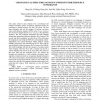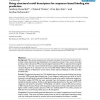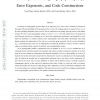193 search results - page 38 / 39 » Sparseness Achievement in Hidden Markov Models |
WISEC
2010
ACM
15 years 6 months ago
2010
ACM
Computing environments on cellphones, especially smartphones, are becoming more open and general-purpose, thus they also become attractive targets of malware. Cellphone malware no...
ICASSP
2009
IEEE
15 years 6 months ago
2009
IEEE
This paper proposes and compares four cross-lingual and bilingual automatic speech recognition techniques under the constraints of limited memory size and CPU speed. The first thr...
ASSETS
2006
ACM
15 years 5 months ago
2006
ACM
CopyCat is an American Sign Language (ASL) game, which uses gesture recognition technology to help young deaf children practice ASL skills. We describe a brief history of the game...
BMCBI
2007
14 years 11 months ago
2007
Background: Many protein sequences are still poorly annotated. Functional characterization of a protein is often improved by the identification of its interaction partners. Here, ...
CORR
2007
Springer
14 years 11 months ago
2007
Springer
An analysis of steganographic systems subject to the following perfect undetectability condition is presented in this paper. Following embedding of the message into the covertext,...



